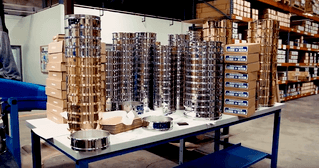What Is a Master Test Sieve Stack? (Definition, Usage, and Cost)
Quality control is a fundamental element of any successful particle size analysis operation. Optimal quality control can sometimes be difficult to maintain and requires analytical lab technicians to implement tools, such as master test sieves, that are designed to keep accuracy on track.
That said, what exactly is a master test sieve and how does it benefit the world of particle size analysis?
At W.S. Tyler, we have over 140 years of particle size analysis experience and have applied our know-how to develop industry-leading test sieves used throughout the world.
This article will establish what a master test sieve is, how they are used, the drawbacks associated with them, how to maintain a master test sieve, and how much a master test sieve costs.
What Is a Master Test Sieve?
A master test sieve is a sieve that an analytical lab technician keeps in their lab to measure the accuracy of their particle size analysis. Typically, master test sieves are utilized in stacks that reflect their working sieve stack.

To put this into perspective, let’s say the lab technician uses six stainless steel sieves to carry out day to day particle size analysis. They would also have a set of sieves that are made of the same material and have the same mesh opening size.
It should be noted that master test sieves work best when certified, however, there are currently no industry standards that encompass the distribution of material.
How Are Master Test Sieves Are Used?
Master test sieves are used as an internal checkpoint to ensure their particle size analysis results are accurate. Running sample material through a set of master test sieves will indicate whether or not your working test sieves have wear and tear that is affecting your test results.
That said, the benefits of master test sieves aren’t exclusive to test sieve analysis. They can and should be applied to any particle size analysis process, including air jet sieve analysis and dynamic image analysis.
Regardless of how you are applying master test sieves, you should use them to test your sample material at least once a month to ensure your particle testing operation continues to yield reliable results.
What Drawbacks Come With Using Master Test Sieves?
When incorporating a stack of master test sieves, it can sometimes be hard to differentiate them from the working sieves. As the openings of the test sieve mesh can become compromised over time, master test sieves should only be used when testing the accuracy of your particle testing operation.
Maintaining Your Master Test Sieves
The same methods you use to maintain an everyday working sieve can be applied to your master sieves to keep them in working order. This includes inspecting for dents and wrinkles in the mesh and frame, inspecting for cracks in the epoxy and solder, properly cleaning the test sieve mesh after each use, and proper storage in between uses.
It is also recommended to have your master sieves periodically recertified, to keep your quality documentation up-to-date. This updated documentation is what will allow you to maintain a successful means of quality control.
For a more in-depth analysis of how to properly maintain your test sieves, refer to our article: 5 Tips for Maintaining your Test Sieves (Best Practices and Cleaning).
How Much Does a Master Test Sieve Cost?
The price of a master sieve is heavily dependent on the needs of your operation. If you strictly want another set of sieves with additional services, you should expect to pay anywhere from $54.02 to $1,380.33 per sieve.
This price, of course, depends on several factors, such as sieve type, alloy, mesh size, sieve size, and certification. For more information regarding the cost of a test sieve, review our article: How Much Does a Test Sieve Cost? (Factors and Price Ranges).
Now, if you want to have your master test sieve certified, the overall cost will reflect the cost of the test sieve plus the cost of the certification process.
If you want the highest level of accuracy and apply the matched test sieve service, the cost will reflect the test sieve plus the $304.76 cost of the matching service.
Keep the Quality Control of Your Operation On Track
Master sieves are a controlled set of test sieves that are often certified and used to measure how accurate a particle size analysis is. While they can be used as a check and balance tool in most lab settings, there are currently no set industry standards that specify material distribution.
When incorporating master test sieves, it is important that you don’t mistake them for your working sieves, as the mesh openings may become compromised and lose their accuracy.
That said, the best maintenance practices are universal and should be applied to working as well as master test sieve.
With over 140 years of particle size analysis experience, W.S. Tyler is here to help guarantee your test sieve analysis yields consistent, repeatable results.
To start assembling a test sieve collection and get a better idea of how much it will cost, fill out Find My Test Sieve Part Numbers form.
Want all the latest industry trends and innovations sent directly to your inbox? Subscribe to our monthly newsletters today!
About Ronnie Brown
Ronnie is the Content Writer for W.S. Tyler and has four years of experience as a professional writer. He strives to expand his knowledge on all things particle analysis and woven wire mesh to leverage his exceptional writing and graphic design skills, creating a one-of-a-kind experience for customers.




